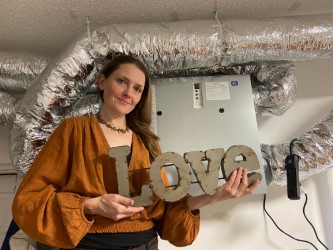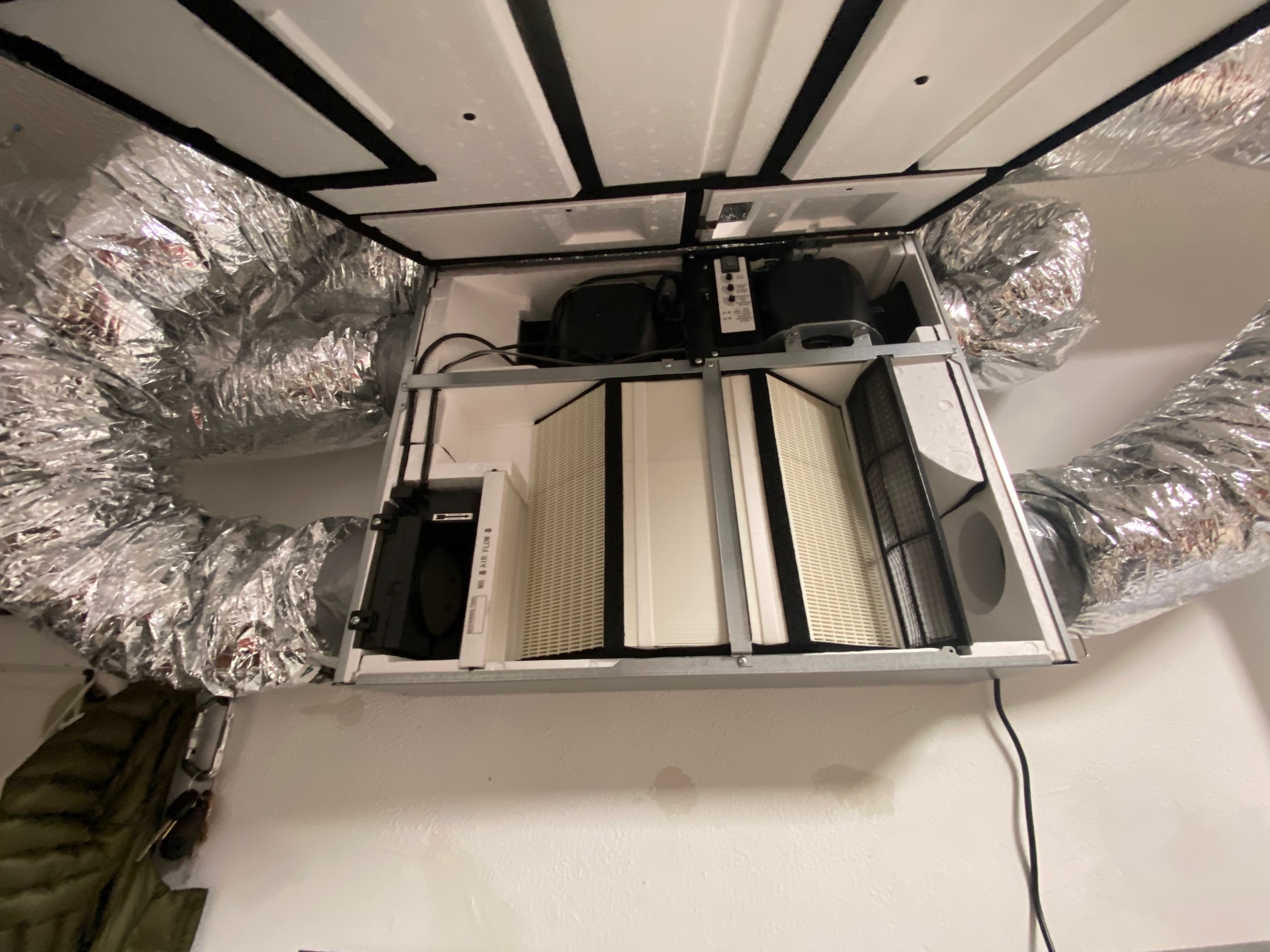
WE LOVE ERV!
ERV. What is it? Energy Recovery Ventilation. The basics are these: Fresh air comes in. Stale air goes out. And the heat or cool, (energy), that you paid for with your utility bill dollars goes from the exiting “stale air” to the incoming “fresh air”, conserving said dollars. The machine that makes this energy transfer happen is called an ERV.
I start with my proposal and then explain ERV further; full story below! Check it out!
What I propose is that ERV be used all the way down to the south lands. That it be used everywhere the outdoor air fluctuates from 71 degrees Fahrenheit and 40% humidity naturally. Anywhere we tend to stay indoors due to inclement weather of any sort, ERV has a place, not only as a cost saving tool for energy recovery, but as a profound tool for maintaining wellness indoors.
Consider that here we are in the time of Covid 19, 6 feet apart and many social things are still only okay done outside. The very finest modern buildings have these systems, but still the fact of this particular element, ERV, is little published. I only encountered a small reference by reading about the northern territories and its most extreme climates, and only in a dry and technical trade journal, and only by accident. The language and description used are so very far removed from the wonder and goodness of fresh air, as though “fresh air” were some how too pedestrian a term and the whole “energy recovery” process needed professionals and experts to weigh in on “quality”.
I further propose that simple and small systems be made available for people renting small spaces and designed for use in windows the same way that air conditioners are used. This insertion of the technology into mainstream culture could have far reaching positive health benefits. The unit you see pictured here with my partner is a Panasonic FV 10-VE2 “intellibalance”. The total cost of the unit, the piping and installation $3,000. This begins to enter the realm of affordable when you start talking about its potential to keep people healthy, working, and out of the doctor’s office!
ERV’s perform a valuable function providing a way to have clean air inside in the winter in a northern climate with minimal thermal loss. Energy Recovery Ventilation makes sense; Wikipedia sites that “half of global energy is used in buildings, and half of that heating/cooling cost is caused by ventilation when it is done by the “open window” method”; and yet the “energy conservation” part of the equation and the “heat/cool” loss factor is but a fraction of ERV-air’s full story.
Here's the full story; fascinated at being exposed to this technology while reviewing building practices in Canada and Alaska I got to thinking not only about the necessity of air exchange in a climate where the outdoor air temperature might be minus 40 F, but also about it’s benefits… Sure, you might die in a well-sealed small home in Alaska if you didn’t go outside or open your doors for a week; you might actually run out of oxygen! But the rest of the story is that precious, “fresh” outdoor air is coming inside in the winter. All of us, the world over, in all languages, have words for fresh air. The air outside the casa or the maison or the imah; aire fresco, air frais, hawa seger, speak to the fact of breathing. And I got to thinking, “why is the air outside, “fresh””? What is it about the outside that “freshens” the air? It turns out that all the plants outside, the trees and the bushes, and the plankton in the ocean, the lichen and the moss, and on and on, all “eat” our carbon dioxide and also all our cooking smells, dog farts, and plastics outgassing, and return to us “fresh air”. We all generally know this from simple science in school, but the huge work accomplished is profound. The world outside our home is cleaning the air we breath for free, every minute of every day, all the time, forever. The rain is falling and washing the pollen, dust, and smog into the streams and rivers and oceans, and that dust and pollen and grit and grime is breaking down, with the plant’s help and being turned back into oxygenated “fresh air”. The trees are literally eating all that we excrete into the air and turning it into breathable air.
We will get to the facts and figures, but suffice it to say for starters that the air outside is A LOT better than your air inside; and especially here in New Mexico. Plastics of every type “outgassing”, cooking smoke, farting dogs, breathing and consuming the oxygen, the list of injuries to our indoor air is long. And opening and closing our doors to come in and out does not offer a significant air exchange. In fact, over the 7 months of actual winter, and the heating season, we might change the air inside, completely, only twice! This equates to breathing, re-breathing, breathing again, and re-breathing yet again, the poorly executed fishy meal from three weeks ago, the dog’s bad gas, and your (fortunately brief) neighbor’s visit, where it was clear he hadn’t showered just yet. Imagine if you could see the air agglomerations and that there were cartoon label bubbles on each one?! While they mix some, they don’t completely mix.
For the last five years I have dreamed about this machine, an ERV. I have thought about Alaskans and Canadians breathing inside their homes through the winter… And somewhere in that dreaming I started to envy them; it occurred to me that “they are, after all breathing “fresh” air, from outside”. And I have pondered the antiseptic name… ERV. This name tells us nothing about the wonder of fresh air, or of air at all. “Ventilation” is a euphemism for the movement of air. And “energy recovery” sounds so very technical. Something you would only need on a space ship for example. Something only possible with gobs of money?! Yet air is nothing short of food and sunlight for us humans. It is essential. Fundamental. Try holding your breath for even 3 minutes. Only a top athlete can hold her breath for 4 minutes; and this well known maximum only describes the loss of 48 breaths of the requisite 672 million! Of course it makes sense to be energy efficient and close the door. We all love being inside our comfy homes, our “air boxes”, in the winter time, but indoor air quality is only cursorily questioned. When we find the room “stuffy” we open the door for fifteen minutes max. And when the day is above 50 in winter we open the door for a half hour at most and even then only if we are brave, mother is not home to mention the utility cost, and we forget that its open!
We step outside our home or tent or car or RV or workshop or factory setting or restaurant-job or job at the dump or step off the subway train, out into the open air and we…breath. We breath in the “better” air. We breath in because we must, but we also relish the quality of a breath. We remember bad breaths. And we remember good breaths. We might remember particularly bad breaths, such as an inhalation of 400 year old adobe dust with no mask on, or the smell of Jeffrey pine- infused-mountain-air taken in Yosemite Valley, for a lifetime. I still remember walking through a dust fog on a job site 2- years ago and choking off and on for a few weeks afterwards. And I well remember stepping out of the family car in the summer of 1976 in Yosemite Valley, for the first time and being overwhelmed at the sheer goodness. A person who lives to 80 years of age will take 672,768,000 breaths. Everyone of them, needed!
In raising this issue, the issue of fresh air, I also raise the issue of how we speak about air and about the other fundamental things in our world. From Wikipedia: Energy recovery ventilation (ERV) is the energy recovery process in residential and commercial HVAC systems that exchanges the energy contained in normally exhausted air of a building or conditioned space, using it to treat (precondition) the incoming outdoor ventilation air. The specific equipment involved may be called an Energy Recovery Ventilator, also abbreviated ERV.
Contrast the above antiseptic language with the words, good air, clean air, fresh air and healthful air. While reviewing ERV it occurred to me that we speak with a kind of technical jargon. We say ventilation when we mean air. We say energy recovery when we mean it cost less than opening the window. But what we aren’t saying is that this is all super awesome. We aren’t mentioning anywhere that this system affords wellness where we would otherwise threaten illness. Nowhere is it mentioned that ERV is a health savior.

- Log in to post comments
